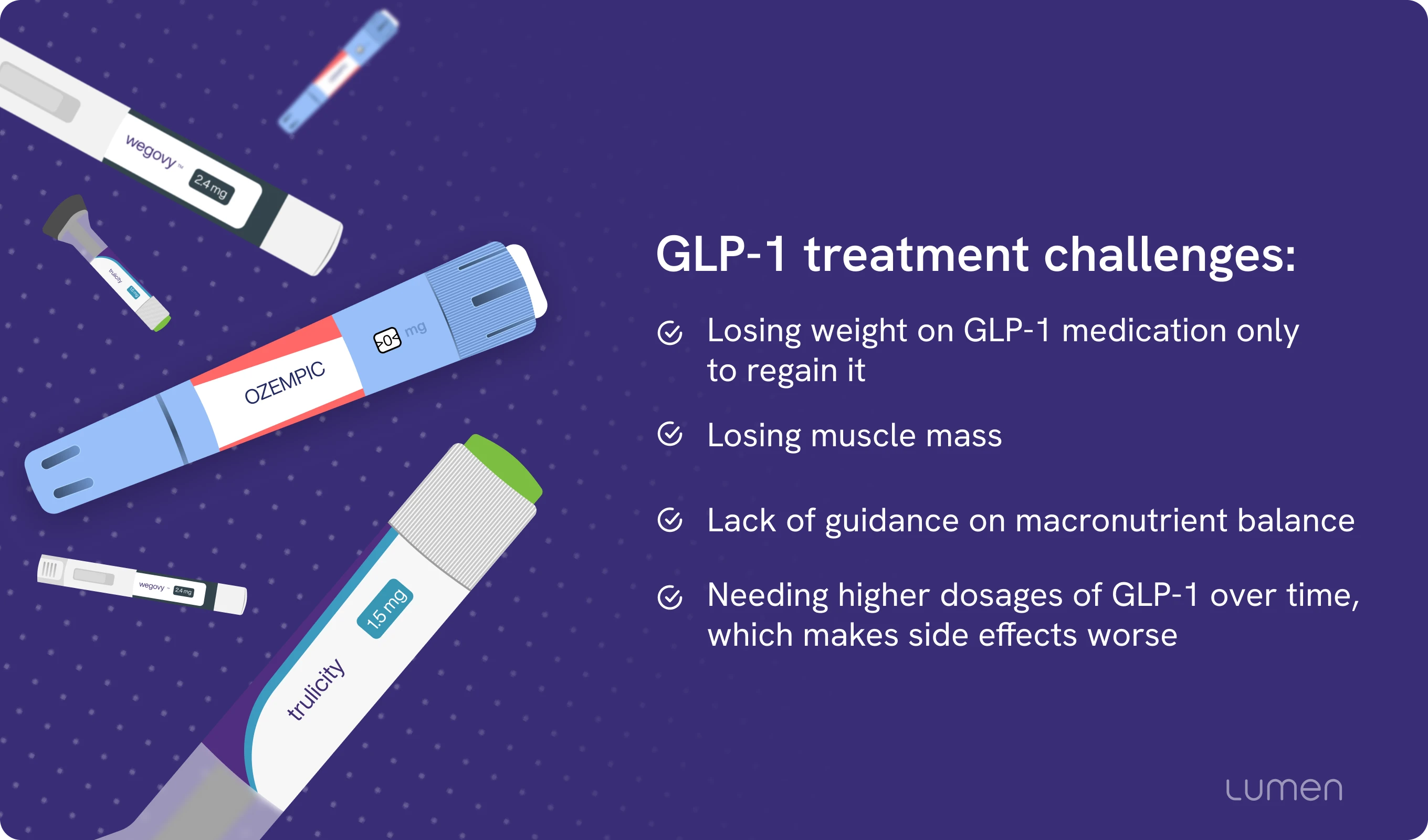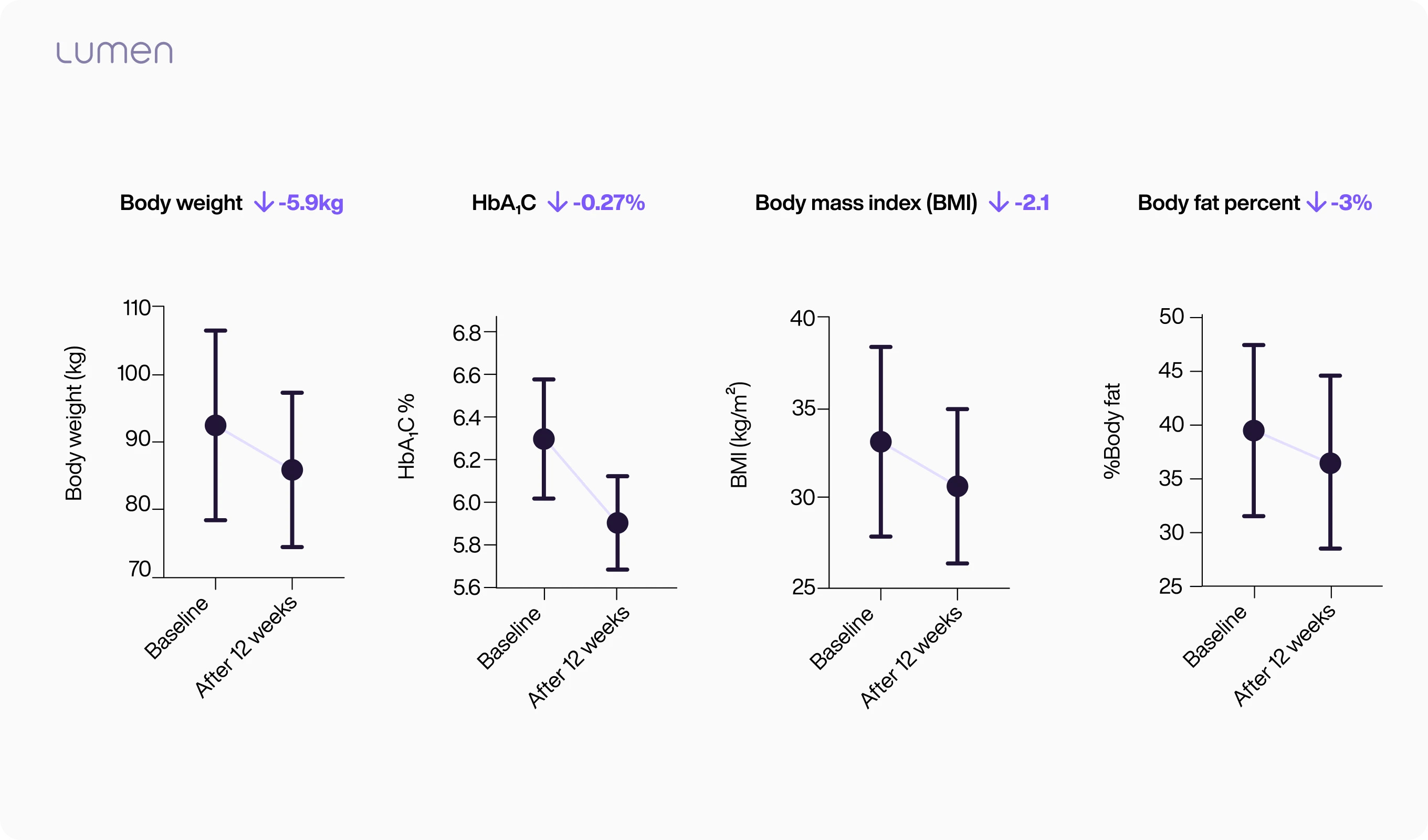How to sustain weight loss and stay healthy while using GLP-1s


Over the last few decades, the prevalence of obesity, prediabetes, and type 2 diabetes (T2DM) has been rising at an alarming rate. In fact, a CDC study estimated that between 22-30% of U.S. adults have metabolic syndrome [1].
Many try everything to lose weight and regain health, but nothing seems to work. It’s because much effort is put into dieting without knowing the true cause of weight and health struggles.
The key to sustainable weight loss lies in improving metabolism, the process by which the mitochondria, the powerhouses of your cells, convert food into energy. When your body’s engine is healthy, it’s not only easier to manage health and weight issues, but you are also more likely to feel energized and motivated.
Excess weight can disrupt this process and increase the risk of developing metabolic-related conditions.
This is why GLP-1 agonists like Ozempic and Wegovy, which aid weight loss, have gained significant popularity over the last few years.
But how exactly do these GLP-1 agonists work, and what else should you know about them?
GLP-1 agonists are a class of medications used primarily to treat type 2 diabetes [2] by mimicking the action of GLP-1, a hormone that regulates appetite and insulin production.
In addition to treating diabetes, these medications have been clinically proven to help with weight loss [3], making them a popular choice for individuals looking to shed pounds and improve their health markers.
For many people, maintaining a healthy weight is a constant struggle, often leading to a cycle of restrictive diets and yo-yo dieting, where lost weight is quickly regained. In fact, studies suggest that more than half of people will regain the weight they lose from traditional diets [4].
Here are a few reasons why this is:
Metabolic inflexibility: Your mitochondria use carbs and fats to produce energy. When you're metabolically flexible, your mitochondria can easily and efficiently switch between fuel sources. You burn more fat at rest and between meals, so you don't need a large calorie deficit to lose weight, and you burn carbs after meals, which prevents fat accumulation. When your mitochondria cannot easily switch between burning both fuel sources, metabolic inflexibility results, which is at the root of weight loss struggles and weight regain.
Metabolic adaptation: Extreme calorie restriction can slow your metabolism, making it harder to continue losing weight and easier to regain it once normal eating resumes.
Hormonal changes: Weight loss can lead to changes in hormones that regulate hunger and satiety, often resulting in increased appetite and cravings [5].
Psychological stress: Constantly striving to lose weight can be mentally exhausting, leading to stress and emotional eating, which can further hinder weight loss efforts.
GLP-1s help with weight loss by:

While GLP-1 medications offer hope, they are not without their own set of challenges:
Some patients experience weight regain once they discontinue GLP-1 therapy, especially if they have yet to make lasting lifestyle changes [6].
Weight loss achieved through medication alone can reduce lean muscle mass, which is crucial for mitochondrial abundance and efficiency.
Over time, patients may require higher doses of GLP-1 medications, which can exacerbate common gastrointestinal side effects and make long-term management more challenging.
The right balance of proteins, carbs, and fats is needed for sustainable weight loss, optimal nutrition, healthy metabolism, and exercise support. Many people taking GLP-1 medications don’t receive the proper nutritional coaching to support sustained weight loss.
Without addressing metabolic inflexibility—the root cause of persistent weight gain, a lot of effort will go into changes that may not have much impact, creating a cycle of frustration and disappointment. To achieve and maintain a healthy metabolism, you need healthy mitochondria.
While GLP-1 medication is a significant breakthrough that can lead to short-term weight loss and decreased blood sugar levels, it does not improve mitochondrial functionality. GLP-1 medication can even worsen root cause issues over time due to common adverse effects like muscle mass reduction.
Mitochondrial health is supported by metabolic mediators, including muscle mass and insulin sensitvity, which are affected by your lifestyle choices. These mediators determine your mitochondrial functionality and, through that, your ability to lose weight and maintain health in the long term. However, typical GLP-1 treatment bypasses them completely.
Lumen is designed to help you get to the root cause of your metabolic issues by addressing the needs of these mediators. This way, you can improve your mitochondrial health and set yourself up for sustainable weight loss and long-term success even after discontinuing GLP-1s.
Lumen’s cross-sectional study indicated that 80% of Lumen users reported a weight loss of 5% or more of their total body weight, with nearly half losing more than 10%. Users more engaged in the program were also observed to experience greater weight loss.
Let’s dive deeper into the mediators and their link to metabolic flexibility.
While GLP-1 medications are effective for weight loss, they can potentially lead to muscle mass loss as a side effect [7]. Muscle tissue is metabolically active and packed with mitochondria, meaning your mitochondria burn more calories at rest compared to fat tissue and make the switch to carb burn when you need a quick energy boost. Losing muscle decreases your mitochondrial abundance, which can slow your metabolism and make it harder to lose weight in the long term.
Lumen provides a daily nutrition plan that follows ADA recommendations for macros, specifically optimized for GLP-1 patients. According to data from clinics using Lumen, clients who take GLP-1 medication and measure their metabolism with Lumen retain 50% more muscle mass than those who do not.
Because GLP-1 medications may be used alongside exercise to maximize weight loss results, measuring metabolism before high-intensity training like weightlifting is important to avoid muscle breakdown. With Lumen, you can track how your body uses carbs and fats and gain insights and personalized recommendations to maintain a balanced diet and preserve muscle mass.
For example, if you’re burning fats before heading to resistance training, that’s a sign to eat some fast-digesting carbs to provide the right fuel for your mitochondria to power your muscles. In the absence of carbs, you risk breaking down muscle mass for a quick boost of energy.
Insulin sensitivity allows your body to efficiently use glucose for energy, preventing excess sugar from being stored as fat. It’s a key factor in achieving and maintaining weight loss and reducing the risk of metabolic syndrome.
Chronically low insulin sensitivity, also known as insulin resistance, means your insulin cannot efficiently shuttle glucose from your bloodstream to your cells. Instead of glucose going into the liver or muscle cells, your body stores the excess sugar as fat, which is how weight gain occurs.
GLP-1 promotes insulin secretion but doesn’t improve insulin sensitivity. Measuring your metabolism when you first wake up helps with early detection of metabolic health conditions like insulin resistance. Waking up in fat burn is the goal since you should be at rest and in a fasted state while sleeping. It’s a sign of balance between the four major areas of your lifestyle: nutrition, movement, sleep, and stress management. Chronically waking up in carb burn can be a precursor to metabolic syndrome and a sign to adjust your lifestyle habits.
You can improve your insulin sensitivity while on GLP-1 by:

Sustaining weight loss and staying healthy while using GLP-1 medication requires a holistic approach that addresses the challenges experienced by GLP-1 patients and supports long-term success by focusing on improving the body's engine and building healthy habits.
When you combine the benefits of GLP-1 agonists with real-time metabolic insights provided by Lumen, you can achieve better results and maintain weight loss more effectively.
This synergistic approach enhances weight loss outcomes and supports overall wellness, making it a valuable strategy for anyone looking to improve their metabolic health and reduce the risk of metabolic syndrome.
To take a deeper dive into GLP-1s and how you can improve your outcomes with Lumen, join our Facebook live event hosted by Lumen’s co-founders, Drs. Michal and Merav Mor:
[1] Moore, J. X., Chaudhary, N., & Akinyemiju, T. (2017). Metabolic Syndrome Prevalence by Race/Ethnicity and Sex in the United States, National Health and Nutrition Examination Survey, 1988-2012. Preventing chronic disease, 14, E24. https://doi.org/10.5888/pcd14.160287
[2] Müller, T. D., Finan, B., Bloom, S. R., D'Alessio, D., Drucker, D. J., Flatt, P. R., Fritsche, A., Gribble, F., Grill, H. J., Habener, J. F., Holst, J. J., Langhans, W., Meier, J. J., Nauck, M. A., Perez-Tilve, D., Pocai, A., Reimann, F., Sandoval, D. A., Schwartz, T. W., Seeley, R. J., … Tschöp, M. H. (2019). Glucagon-like peptide 1 (GLP-1). Molecular metabolism, 30, 72–130. https://doi.org/10.1016/j.molmet.2019.09.010
[3] Singh, G., Krauthamer, M., & Bjalme-Evans, M. (2022). Wegovy (semaglutide): a new weight loss drug for chronic weight management. Journal of investigative medicine : the official publication of the American Federation for Clinical Research, 70(1), 5–13. https://doi.org/10.1136/jim-2021-001952
[4] Hall, K. D., & Kahan, S. (2018). Maintenance of Lost Weight and Long-Term Management of Obesity. The Medical clinics of North America, 102(1), 183–197. https://doi.org/10.1016/j.mcna.2017.08.012
[5] Kuckuck, S., van der Valk, E. S., Scheurink, A. J. W., Lengton, R., Mohseni, M., Visser, J. A., Iyer, A. M., van den Berg, S. A. A., & van Rossum, E. F. C. (2023). Levels of hormones regulating appetite and energy homeostasis in response to a 1.5-Year combined lifestyle intervention for obesity. Frontiers in physiology, 14, 1010858. https://doi.org/10.3389/fphys.2023.1010858
[6] Jensterle, M., Rizzo, M., Haluzík, M., & Janež, A. (2022). Efficacy of GLP-1 RA Approved for Weight Management in Patients With or Without Diabetes: A Narrative Review. Advances in therapy, 39(6), 2452–2467. https://doi.org/10.1007/s12325-022-02153-x
[7] McCarthy, D., & Berg, A. (2021). Weight Loss Strategies and the Risk of Skeletal Muscle Mass Loss. Nutrients, 13(7), 2473. https://doi.org/10.3390/nu13072473
[8] Buch, A., Yeshurun, S., Cramer, T., Baumann, A., Sencelsky, Y., Zelber Sagi, S., Serebro, M., Greenman, Y., Mor, M., & Eldor, R. (2023). The Effects of Metabolism Tracker Device (Lumen) Usage on Metabolic Control in Adults with Prediabetes: Pilot Clinical Trial. Obesity facts, 16(1), 53–61. https://doi.org/10.1159/000527227

Our Lumen editorial desk includes an in-house team of certified and registered nutritionists and dietitians, scientists, researchers, and writers.